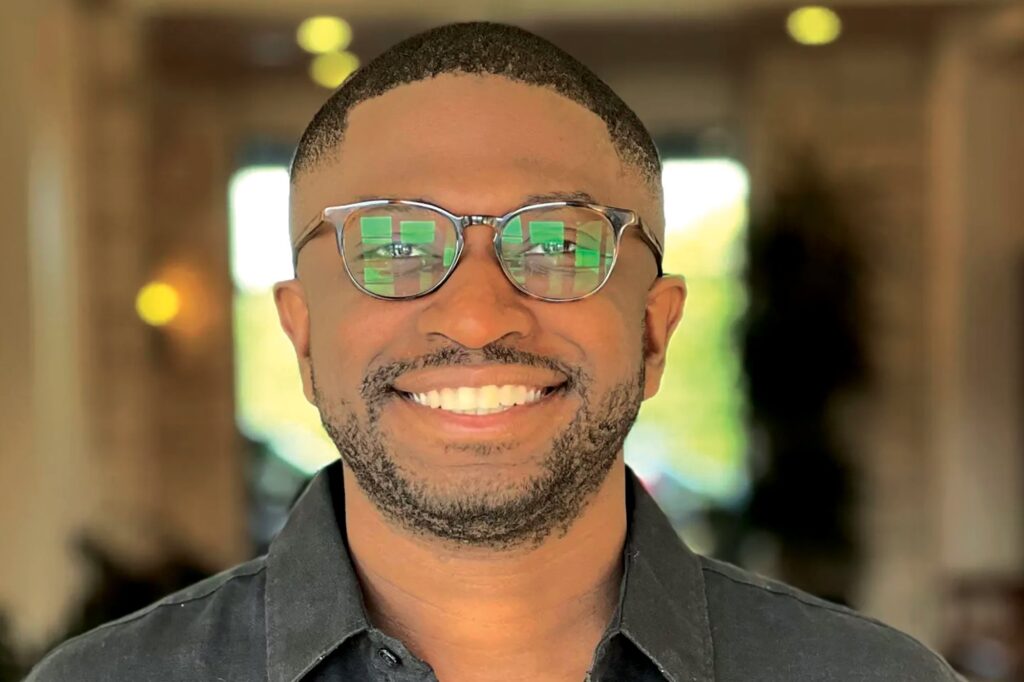Tade Oyerinde has been making connections from the beginning. It all started after several years of homeschooling. “By the time you hit puberty, you want to be more social. You want to meet people, you want to meet girls in particular. You want to make friends. So I had this desire for an online-learning platform. I used to call it ‘Skype but for education,'” he said. Today, that vision has become Campus, a virtual community college that pays its professors double the national average while keeping tuition below that of the federal Pell Grant for undergrad students.
Campus is Oyerinde’s fourth company. Initially, his thinking led him to imagine other ways to connect people virtually. While attending the University of Leeds in 2012, Oyerinde started his first business with his twin brother and a flatmate. Called Gleepost, it was meant to be a Craigslist alternative for students to sell and buy textbooks. When they encountered difficulty driving traffic to the site, the team built UniRoulette, a video chatting platform based on the webcam-based conversation platform Chatroulette, but for users with valid .edu email addresses.
UniRoulette “took off immediately,” according to Oyerinde, who shared that the team raised $500K from angel investors in London. “Some reached out to us, others I reached out to, others I was introduced to from mutual connections I knew and others still I would meet at pitch events,” said Oyerinde. “We went viral and grew like crazy, before totally collapsing relatively quickly. In the end, it was just a fad.”
What remained were the connections he made, the skills he gained and advice he received from people in the industry. So when he saw Slack booming in the workplace and Discord taking off for gamers in 2016, Oyerinde came back to his original idea. “I thought, Man, what if we built something like that, but with video for colleges and universities, so that online learning doesn’t have to be just watching a pre-recorded video, like on Coursera? You’re not making any friends. You’re not actually interacting with the professors or the TAs. It’s very lonely and sort of anti-social. So what if we built a great platform that enables synchronous online learning, so you can be face-to-face, you can read body language, you can make friends and build relationships?“
Related: 5 Entrepreneurial Mindsets That Drive Success
That thought was the beginning of Campuswire, a software that allows teachers to better communicate with their students by providing a platform that can host online discussion forums and real-time virtual lessons, as well as allow messaging, assignment submission and grading.
By the end of the year, Oyerinde and two friends raised $600K in a first round of funding by reaching out to groups he had previously pitched, and asking for introductions from other founder friends. This allowed Oyerinde and his new team to build out the tech for the product and launch in 2018.
Though initially successful, it was the pandemic that catapulted Campuswire to new heights as schools shut down and demand grew exponentially for online learning platforms in 2020. But after being in the education space for several years and learning more about the inner workings of higher education, Oyerinde felt like there were more effective ways to make a difference. “I wanted to do more. I think in our country, young people need to have a cheap, low-cost, high-quality way to get associate’s degrees,” said Oyerinde. “So in 2020, I decided: I don’t want to just build software for online learning, I actually want to acquire a community college and implement my vision and my model for the future of community college within it.” And that’s what he did: Oyerinde acquired a community college and started to build the school he’d long dreamt of.
“I decided to build Campus — on top of Campuswire — with the goal of bringing high-quality, 2-year college programs to everyone, with no debt. Synchronous learning, for me, was a big part of what would make for a quality educational experience. Ironically, that meant leaning on some of the experiences that we had building real-time social features, years earlier.”
Since then, Campus has raised more than $65 million from investors like Sam Altman, Discord’s Jason Citron and Shaquille O’Neal. This past spring, their first cohort of students graduated, and in the two years since their launch, enrollment has gone from 100 students to 1,100, plus 500 in-person students. All of this earned Oyerinde a finalist spot on our Entrepreneur of 2024 list of 20 innovative leaders.
What makes Campus different? Why do you think it has found success?
We understand that the future of community college and two-year programs is largely online. If you think about a four-year university, yeah, it’s education, but it’s also a dating app, it’s also a social network, it’s also a country club for upper-middle-class kids. Community college is none of those things. There’s no sports, no clubs, no societies, no dorms. You live at home, come in to take your classes, then go back home.
And so when it sort of naturally went online in 2020, it made sense that it would stay online after, which has largely been true. Forty percent of community college students are exclusively online all this time after the pandemic. Campus realizes this and is a two-year college where all the classes are live, and they are taught online by a distributed network of professors who are part-time with us, while teaching primarily at the top 50 schools in the country, including schools like Princeton and UCLA. They do it because we pay them really well, and they’re always looking for remote teaching opportunities. They keep their primary job on their campus, and then they also teach with us in virtual, live classes.
And for students, our tuition is $7,200 a year, which about 82% of community college students are eligible for, which is lower than a Pell Grant. And so for our students, 86% don’t pay anything out of pocket, because the Pell Grant, which is not a loan, covers their tuition, and we ensure success by giving them a laptop and connecting them with a career coach to really help them understand, ‘Why am I here? What is my purpose?’ — which we define as the intersection of ‘What are you naturally gifted in?’ ‘What are you passionate about?’ and ‘What will the world pay you for?’ Most kids don’t have any idea — even kids who go to elite universities. And we found that if students can actually articulate that vocally, they are far more likely to actually do the work and actually graduate. We also pay for about 90% of our students’ WiFi, as well as offer free tutoring in math and English and mental health resources.
Related: 3 Values That Empower Entrepreneurs As They Start Their Business Journeys
How are you able to provide and fund all of this?
One of the main variables that underpins our economic model is the average class size. It’s actually quite unideal to have an average class size that is low, because you can’t pay the faculty well. We pay faculty double what a typical community college pays their adjunct professors because we found that we can have one professor with about 150 students in their class, along with one TA for every 25 students. This works because the professor is paid well and the TAs can help with grading and additional office hours and support. A lot of community colleges can’t do this for a variety of reasons, like unions or because they offer smaller, niche classes which are probably really fun, but not ultimately that useful to the primary goal of getting the students into a high-paying, successful career.
Paying faculty well then attracts high-quality faculty. In 2018, I met an adjunct professor at UCLA who was living out of his office because he didn’t make enough to live near Westwood, where UCLA is. I was totally shocked. Then a few months later, another UCLA professor emailed asking to connect his UCLA and Santa Monica College Campuswire accounts, because he taught at both. And I thought it was interesting that a small community college was sharing professors with UCLA and the students were getting UCLA quality instruction for a fraction of the cost.
So I dug in on the community college space and figured out that one of the big challenges is that most kids who go to community college don’t ever graduate. Why are they struggling to actually graduate these young people? A lack of sufficient student support is the simple answer, and most community colleges don’t have the resources to actually be able to provide that sufficient level of support.
And that’s another part of the model — the graduation rate. When you sit back and put the word “college” to the side for a second and look at this as a business, students are the customers, and the professors and support staff are like employees. When you lose customers, you lose revenue. So with typical community colleges, when two-thirds of the customers don’t graduate, that means lost revenue. Our model works, and we can be more supportive, because we actually keep more students. The more students that you save, the more revenue that you have to invest in saving more students.
So those are the two major levers that make our economics work better. And then, of course, all of this was unproven when we started, so we had to fundraise. And we were super fortunate to have the support of people like Jason Citron, the founder of Discord, and Sam Altman, who I met through Jason before he launched ChatGPT, thankfully. It probably would be too hard to meet him now. And Bloomberg Ventures, who funded me back in 2016, and then, of course, the team that helped fund the acquisition of the college, among others.
Related: The Simple Question That Can Spark Innovation for Your Business
You’ve spoken about the role of luck in your success. You obviously do a lot of research, but why do you think the risks that you took worked out?
So I think there’s good luck and there’s bad luck. One of the worst things that happened to us was that we spent 18 months trying to buy another college owned by this family out in Illinois. And I kid you not, the day before we were going to submit the deal for regulatory approval, the Department of Education opened an investigation on the school for malfeasance. That was 18 months of work down the drain. Worse things have also happened. And so bad luck happens, but good luck also happens, and I think you just kind of have to roll with the punches when the bad luck happens, and triple down when the good luck happens.
As for why the risks have paid off, I think that the major thing that Silicon Valley misses is that we overindex on the engineering culture and underindex on strategy. I’m an engineer. I studied aerospace engineering, which is even more hardcore than computer programming. But the engineering approach to everything in Silicon Valley is basically to just build a minimum viable product, get it out there and start learning from the customers. That’s how an engineer would build a business. But there’s this other approach, which is more of sitting down, doing research and writing a white paper. When I wanted to build Campus, I literally wrote a white paper on the space, on the opportunity, on the pitfalls, on the risks, on how you can mitigate the risks, on how big this opportunity is for the country. I was super thoughtful about the strategy upfront, especially because I was pivoting, and I knew I had to have a reason to tell the board [during the pandemic], “Hey, we’re going to turn down millions of dollars in revenue because I don’t think it’s going to last,” when everyone else at the time really felt like the world was never going to go back to normal. And I said, “No, these four-year colleges are going to go back to campus and are not going to use our software in 18 months. And so I think that strategic decision would be to create what the world needs: a high-quality community college experience. Here’s the information that proves why. And here’s why community college should stay online post-pandemic.”
That was the big bet that ended up paying off — which, by the way, wasn’t really a bet because of the research we did. You could actually see that it was going to work because if you look at higher education in America, it’s a $500 billion market, and almost all of it is tuition. It’s not software licensing. So if you can figure out a way to earn tuition, then you have much more access to the market, just as a pure economic opportunity. So anyway, that was something a lot of people missed but we saw because we took the strategic approach.
What is one of the most worthwhile investments you’ve made, whether it’s money, time or energy?
One of the best investments I’ve made is developing relationships and surrounding myself with experts who are retired. In Silicon Valley, sort of what you want to do if you’re a seed stage founder or Series A founder is that you want to meet with Series B or Series C founders who are five years ahead of you, and get to know them, like I did with Jason and Sam, because they can help you navigate all the drama that you’re gonna go through in your startup journey, because they’ve been through most of it. And then if you have a relationship with them they can help with fundraising and various things.
With higher ed it’s different. If you try and reach out to a 45-year-old-college president, they won’t even pick up the phone because they’re so in it. So one of the best investments I’ve made was getting to know all of these former presidents of colleges and universities, former chancellors, former regulators. Some of them are even now on my board of trustees because these folks have been around, and they’ve seen attempts. So when they validated the core thesis of Campus, that was extremely empowering, and it allowed me to run through all the walls I’ve had to run through.
So that’s probably one of the best investments I’ve made because there’s so much wisdom and expertise that I gleaned from true experts. It’s been invaluable and it’s probably saved, like, five years in the company’s journey.
That’s great advice for any entrepreneur starting out. Is there any bad advice you’ve heard, or anything you’ve seen that someone just starting out should avoid?
There’s a ton of bad advice. The problem is people give advice that works for them, and every situation isn’t always the same. And so what advice is universally applicable versus contextually relevant, I don’t think most people can tell. So I’m always humble when giving advice because every startup is different.
But I will say, specifically for people who are trying to do good in the world, I see so many people who want to build education companies and they use this almost social justice lens to talk about it. And yeah, these people are experiencing housing insecurity or economic injustice and all this stuff, but how I’ve found talking about this that gets people excited is about how it’s a huge freaking opportunity. Every single young person needs to figure out how to get the skills and the knowledge — and the credentials that prove they have the skills and the knowledge — to create the life that they want for themselves. That’s a massive opportunity. Just think about how many people can find purpose in their careers. That’s how I talk about it, and I think it’s opened doors.
Most of our investors are not education investors, they’re not social justice investors. They just want to change the world. And so I think for founders who care about making the world a better place, learning how to discuss their vision in a way that is about the scale and the magnitude of the opportunity, as opposed to the social justice-y, good-feeling way, I think that would open up a whole new aperture of investor excitement.
And not just investors. You need investors, but you also need people to come work with you on this journey. And you need the best. And the best people want to work on the most epic stuff, the stuff that movies are going to be made about if you succeed. So while as a founder you may be driven by the sort of social justice outcome, framing your work within the context of a massive opportunity that really matters, an epic quest to go on, I think, is something that has been successful for us.
Related: You Need a Community With Shared Values to Find Long-Term Success — Here’s How to Cultivate It.
Read the full article here












